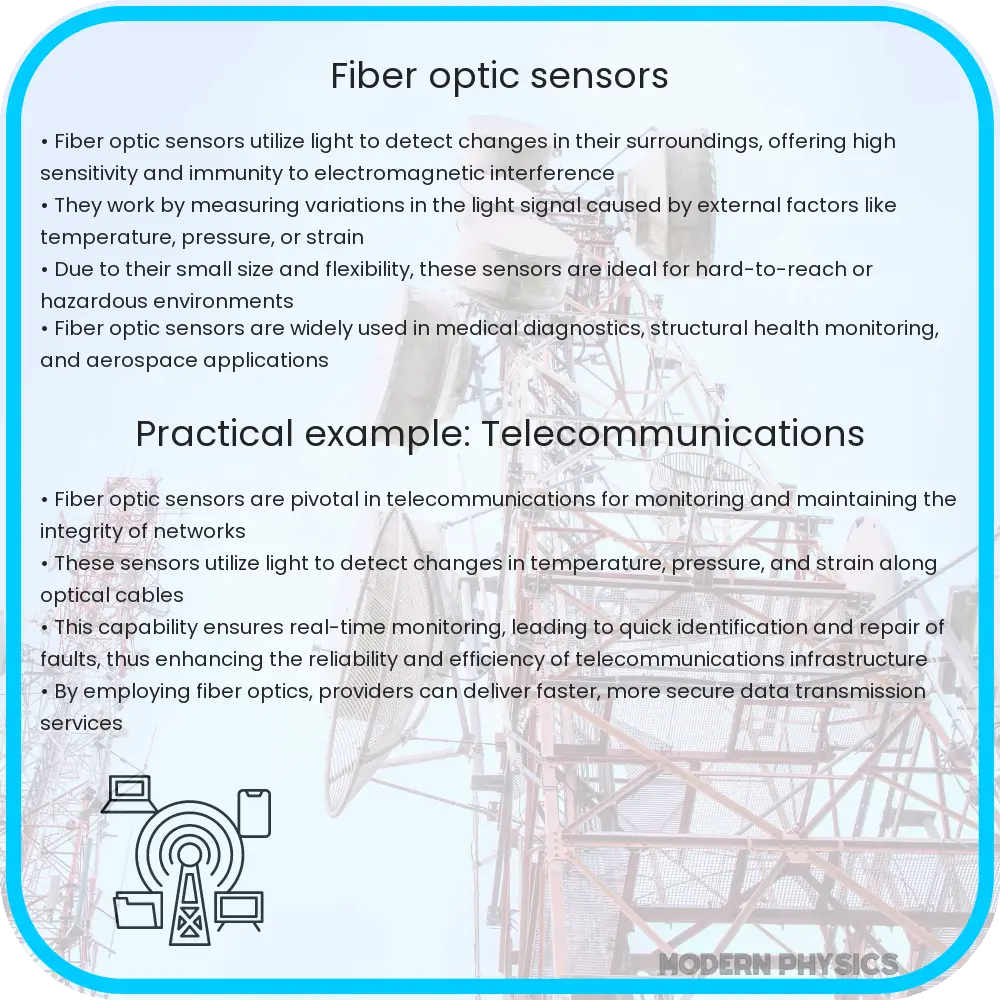Explore the advantages of fiber optic sensors, showcasing their precision, speed, and versatility in various applications, from medical to engineering fields.

Fiber Optic Sensors: Revolutionizing Precision, Speed, and Versatility in Measurement Technologies
Fiber optic sensors represent a groundbreaking shift in the realm of measurement and detection technologies, providing unparalleled precision, speed, and versatility. Leveraging the principles of optics and photonics, these sensors harness light to detect changes in various parameters such as temperature, pressure, strain, and more, with applications spanning from medical diagnostics to structural health monitoring.
How Fiber Optic Sensors Work
At the heart of fiber optic sensor technology is the use of optical fibers, which are thin strands of glass or plastic that guide light from one point to another. These sensors operate by modifying the light properties, such as intensity, phase, wavelength, or polarization, in response to external stimuli. The changes in light properties are then analyzed to measure the physical quantity of interest.
- Intensity-Based Sensors: Measure changes in light intensity that occur due to external influences, offering a simple and cost-effective solution for various applications.
- Phase-Based Sensors: Utilize the phase shift of light waves to detect changes in environmental conditions, providing high sensitivity and accuracy.
- Wavelength-Based Sensors: Detect shifts in the wavelength (color) of the light, which can indicate temperature variations or strain, enabling precise measurements over long distances.
- Polarization-Based Sensors: Monitor alterations in the polarization state of light, useful for measuring physical quantities that affect light polarization, such as stress or magnetic fields.
Advantages of Fiber Optic Sensors
The use of fiber optic sensors comes with a host of advantages that make them superior to traditional sensing technologies. These include:
- High Precision and Sensitivity: Capable of detecting minute changes in physical parameters, fiber optic sensors offer unmatched accuracy.
- Immunity to Electromagnetic Interference: Unlike electronic sensors, fiber optic sensors are not affected by electromagnetic fields, making them ideal for use in harsh environments.
- Versatility: They can be used to measure a wide range of physical quantities and are suitable for various applications across industries.
- Remote Sensing Capability: The ability to perform measurements over long distances without loss of signal integrity allows for monitoring in inaccessible or hazardous areas.
With these advantages, fiber optic sensors are at the forefront of innovation in the field of optical measurement, offering solutions that are both versatile and reliable for a myriad of applications.
The Advent of Fiber Optic Sensors
Fiber optic sensors represent a significant leap forward in the realm of sensing technology. These devices leverage the unique properties of light within optical fibers to detect changes in various parameters, such as temperature, pressure, and strain. The precision, speed, and versatility of fiber optic sensors make them indispensable in industries where high sensitivity and real-time monitoring are paramount.
How Fiber Optic Sensors Work
At the heart of fiber optic sensing technology lies the principle of light modulation. When light travels through an optical fiber, any changes in the external conditions affecting the fiber can alter the intensity, phase, wavelength, or polarization of the transmitted light. By measuring these changes, fiber optic sensors can deduce the magnitude of the physical effect causing them. This allows for the detection of a wide range of phenomena with remarkable precision and speed.
Types and Applications of Fiber Optic Sensors
- Intrinsic Sensors: These sensors utilize the optical fiber itself as the sensing element. Changes in light properties are directly related to the physical changes the fiber experiences. Applications include structural health monitoring, where they can detect stress or cracks within materials.
- Extrinsic Sensors: In these systems, the fiber optic cable acts as a means to transmit light to and from the sensing element. They are widely used in medical diagnostics and biochemical sensing, leveraging their ability to perform non-invasive measurements.
Advantages Over Traditional Sensors
Fiber optic sensors offer several advantages over their traditional counterparts:
- High Sensitivity: Capable of detecting minute changes in the measured variables.
- Electromagnetic Immunity: Unlike electronic sensors, fiber optic sensors are immune to electromagnetic interference, making them ideal for use in harsh environments.
- Remote Sensing Capability: The ability to measure phenomena over long distances without loss of accuracy or signal quality.
Conclusion
The integration of fiber optic sensors into various fields has revolutionized the way we monitor, diagnose, and manage complex systems. Their unparalleled precision, speed, and versatility enable advanced applications in industries ranging from aerospace to biomedicine. As technology advances, the scope of fiber optic sensing will undoubtedly expand, offering new solutions to measurement challenges and opening avenues for innovation. With ongoing research and development, the future of fiber optic sensors promises even greater capabilities, reinforcing their status as a cornerstone of modern sensing technology.
